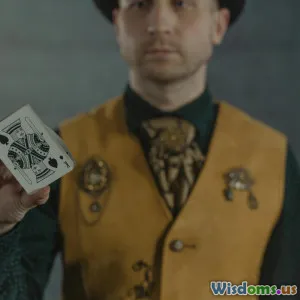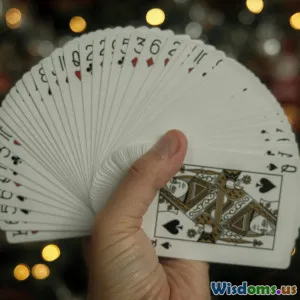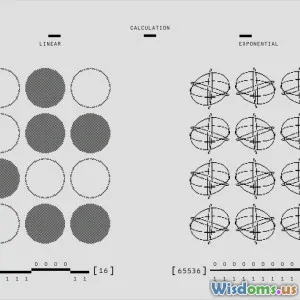
Five CloseUp Magic Tricks Anyone Can Learn Fast
9 min read Master five quick and impressive close-up magic tricks to amaze friends and family with minimal practice. (0 Reviews)
Five CloseUp Magic Tricks Anyone Can Learn Fast
Introduction
Imagine captivating a crowd of friends with just a deck of cards, a few coins, or even everyday objects from your pocket. Close-up magic isn’t just for professional magicians; it’s an art form anyone can learn with minimal time and effort. The charm of close-up magic lies in its intimacy and immediacy, turning ordinary moments into unforgettable experiences.
This article unlocks five easy-to-learn close-up magic tricks that require no expensive equipment or years of practice. Each trick is handpicked for quick mastery and maximum ‘wow!’ factor whether you’re entertaining at a party, social gathering, or just looking to impress colleagues.
1. The Vanishing Coin
Why It Works
The vanishing coin is a classic demonstration of sleight of hand. It relies on palm concealment and misdirection — two core magic principles. Because many people carry coins, this trick is perfect for spontaneous performances.
Step-by-Step Instructions
- Hold a coin between your thumb and index finger.
- Pretend to transfer the coin to your other hand by miming the motion but secretly retain it palmed in your original hand.
- Close the receiving hand and make a magical gesture.
- Open the receiving hand to reveal the coin has vanished.
- Drop the palmed coin secretly or produce it again for a surprising reappearance.
Pro Tips
- Practice palming with a coin until it feels natural and comfortable.
- Use patter (talking) to distract your audience’s attention during the coin transfer.
- The angle matters; perform this with your palm facing away from the audience.
Real-World Insight
David Roth, renowned coin magician, emphasized that the key to convincing vanishing coins is fluidity and confidence rather than complicated moves. Mastery comes from practicing smooth hand movements.
2. The Ambitious Card Routine (Simplified)
Why It Works
The ambitious card effect creates suspense and amazement as a signed card repeatedly jumps to the top of the deck despite apparent controls. Its core is simple and can be adapted.
Simplified Routine for Beginners
- Have a spectator select any card and sign it.
- Control the signed card back to the top of the deck (using an overhand shuffle or side slip).
- Show the top card; it's their signed card!
- Repeat a couple of times, varying the presentation by placing the card into the middle or bottom before magically bringing it to the top.
Pro Tips
- Learn basic card controls like the double lift and overhand shuffle control.
- Use casual patter and natural hand movements to avoid suspicion.
- Don't rush; suspense is part of the magic.
Historical Note
The Ambitious Card is a cornerstone in card magic, dating back centuries. Its enduring popularity is due to adaptability and audience engagement.
3. The Floating Ring Illusion
Why It Works
Using a simple piece of thread or clear fishing line, this illusion creates the appearance of a ring that mysteriously floats up and down your arm.
What You Need
- A small ring (like a wedding band or key ring)
- Clear thread or monofilament fishing line
Perform the Trick
- Thread the ring onto the invisible line.
- Attach one end of the thread to your finger and hold the other taut with your other fingers.
- Tilt your hand slightly and gently move your fingers to make the ring glide up or down.
- Use steady angles of view and natural movements.
Pro Tips
- Adjust lighting to minimize thread visibility.
- Practice hand movements in front of a mirror.
- Ensure your audience’s viewpoint is restricted to avoid detection.
Expert Insight
Many professional magicians use monofilament for levitation effects. Beginners can achieve impressive results with patience and controlling angles.
4. The Sponge Ball Multiply
Why It Works
Sponge balls are soft and easy to conceal, making them one of the most beginner-friendly props. The multiply effect is charming and surprises audiences by making one ball become two, then three.
Materials Needed
- Set of two or three sponge balls (widely available online or in magic shops)
Performing the Multiply
- Hold one sponge ball in your palm.
- Secretly hide a second ball in the other hand or palm.
- Pretend to take the ball from one hand to the other but secretly retain one.
- Open your hands to reveal two balls.
- Repeat for three balls as flair.
Tips for Perfecting
- Practice squeezing and manipulating sponge balls to avoid detection.
- Employ misdirection with your eyes and patter.
Practical Usage
Sponge ball tricks are often used in close-ups, street performances, and children’s parties because of their tactile, visual appeal.
5. The Mind Reading Number Prediction
Why It Works
Combining simple mathematics and showmanship, this mind-reading trick creates an illusion of psychic ability without complex props.
The Setup
No props are actually needed, but you can write a prediction on a card beforehand.
How to Perform
- Ask the spectator to pick any two-digit number.
- Instruct them to add the two digits together.
- Have them subtract the sum from their original number.
- Dramatically reveal you ‘knew’ their number — it will always be a multiple of 9, typically 9, 18, 27, etc.
Presentation Tips
- Engage your audience with suspense and confident delivery.
- Personalize the prediction by writing beforehand or using a sealed envelope.
Cognitive Note
This trick is a simple example of mathematical principles used in magic. It’s popular because it requires no equipment yet yields astonishing results.
Conclusion
Close-up magic’s power lies in transforming everyday objects into tools of wonder. These five tricks are accessible gateways into a world where misdirection, dexterity, and presentation turn simple moments into extraordinary memories.
By practicing the vanishing coin, mastering a simplified ambitious card trick, creating the floating ring illusion, performing sponge ball multiplies, and executing mind-reading predictions, you’ll develop foundational skills that build confidence and inspire creativity.
Remember, while technique is crucial, your enthusiasm and connection with the audience make the magic truly memorable. So grab your coins, cards, rings, and sponge balls and start enchantingly fooling people today — magic is in your hands.
Suggested Resources: To delve deeper, consider titles like "Mark Wilson’s Complete Course in Magic" or online tutorials from professional magicians who specialize in close-up magic.
Interesting Quote: "Magic is not about tricks, it's about creating a moment of astonishment and joy." — David Copperfield
Rate the Post
User Reviews
Popular Posts
















